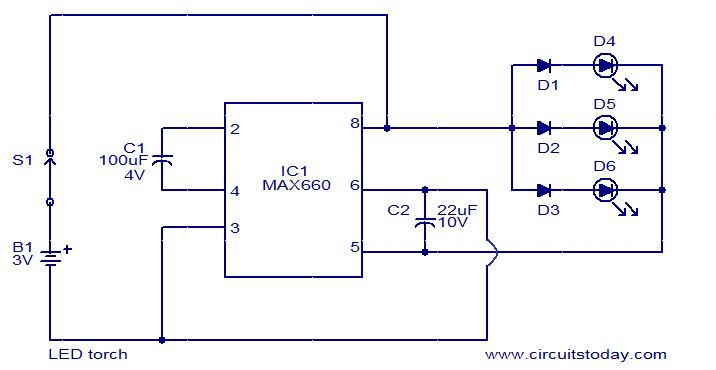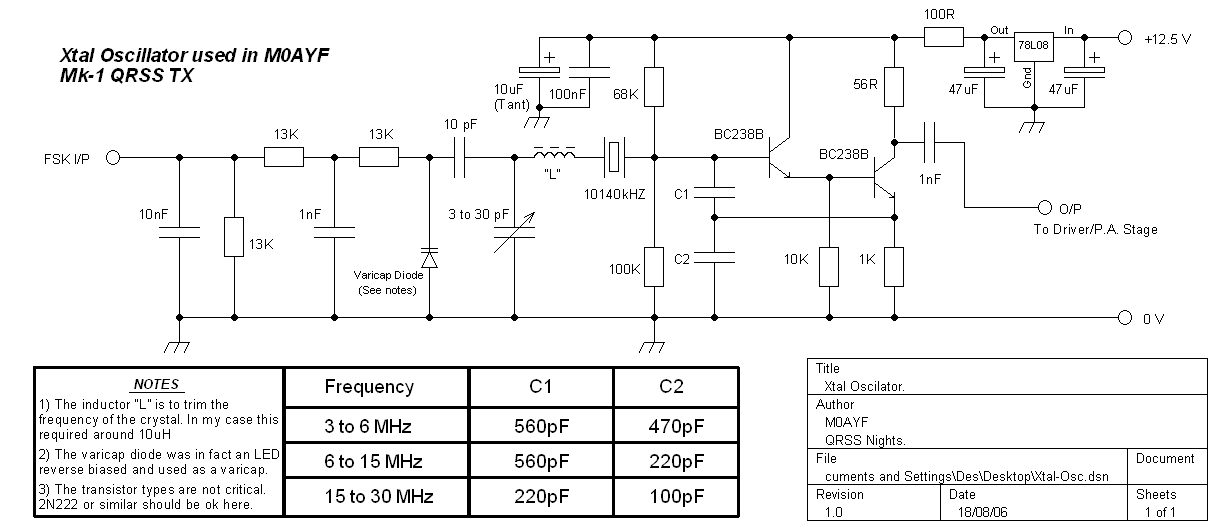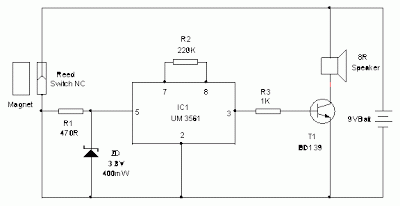
Simple receiver with microvolt sensitivity

The three-transistor circuit costs less than $10 to build, uses commonly available components, and consumes less than 10 mA from a single 9V battery. By winding coil L1 as shown, the circuit can receive signals in the 5 to 15 MHz short-wave band. Adjusting the number of turns on L1 or changing C2 allows tuning to different frequencies. Q1, a 10 bipolar transistor, serves as a high-gain regenerative stage, amplifying microvolt-level signals from the antenna to hundreds of millivolts to drive diode-detector D1. Regeneration increases the circuit's Q (selectivity), producing a high-Q circuit that can utilize low-cost or hand-wound coils. A high-transconductance bipolar transistor for Q1 offers greater gain per microamp than vacuum tubes or JFETs. However, controlling the regeneration level in previous bipolar circuits has been challenging. In this design, R1 and R2 provide substantial negative bias at Q1's emitter for smooth control, while R3 allows user-adjustable regeneration. The pot should be set so that Q1 is at the threshold of oscillation, maximizing both gain and selectivity. Q2 and Q3 form a two-transistor amplifier that sufficiently amplifies the detected audio signal from D1 to drive headphones or a small speaker. Replacing R3 with a 2-kOhm potentiometer and connecting C3 to its wiper can turn R3 into a volume control. R4 and C4 create a low-pass filter that stabilizes the circuit and enhances sound quality. D2, D3, and D4 implement a low-cost voltage regulator to maintain a constant voltage for Q1, minimizing drift. The receiver operates with a short whip antenna connected to the tuning capacitor C2 or an external antenna for improved reception. When using an external antenna, C must decouple the antenna's capacitance from L1. The regenerative stage of Q1 operates at less than 30 µW (50 µA at 0.6V), preventing interference with nearby receivers, a common issue with tube-type regenerative receivers in the 1920s and 1930s that dissipated several watts of power.
This three-transistor circuit is designed for efficient short-wave radio signal reception, leveraging a cost-effective and compact approach. The circuit's architecture includes a regenerative amplifier stage with Q1, which is pivotal for boosting weak signals captured by the antenna. The choice of a bipolar transistor for Q1 is significant, as it provides a high transconductance, enabling substantial amplification from minimal current input. The regenerative feedback mechanism enhances the selectivity of the circuit, allowing it to distinguish between closely spaced frequencies, which is essential in crowded radio bands.
Components R1 and R2 are critical for establishing the operating point of Q1, ensuring that the transistor remains in its active region while providing the necessary negative feedback to control the regeneration. The adjustable resistor R3 permits fine-tuning of the regeneration level, allowing users to optimize performance based on specific reception conditions. The subsequent amplification stages, Q2 and Q3, are designed to deliver sufficient output power to drive audio output devices, ensuring that the audio signal is clear and audible.
The inclusion of a low-pass filter formed by R4 and C4 is essential for reducing high-frequency noise that could degrade audio quality. This filter works by allowing only the desired audio frequencies to pass while attenuating unwanted signals. The voltage regulation provided by D2, D3, and D4 is a noteworthy feature, as it stabilizes the power supply to Q1, which is crucial for maintaining consistent performance and minimizing drift in signal reception.
The circuit's low power consumption, particularly in the regenerative stage, is a significant advantage, as it reduces the risk of interference with other receivers. This characteristic is particularly beneficial in environments where multiple receivers may be operating simultaneously. Overall, this three-transistor circuit exemplifies an effective solution for short-wave radio reception, balancing performance, cost, and component availability.The three-transistor circuit in Fig 1 costs less than $10 to build, uses commonly available components, and consumes less than 10 mA from a single 9V battery. If you wind coil L1, as the figure shows, the circuit receives signals in the 5- to 15-MHz short-wave band.
You can add turns to or subtract turns from L(or change C2) to receive other frequ encies. Q1, a 10 bipolar transistor, acts as a high-gain regenerative stage and amplifies microvolt-level signals at the antenna up to hundreds of millivolts to drive diode-detector D1. In addition to providing high gain, regeneration also greatly increases the Q (selectivity) of the circuit, producing a high-Q circuit, which can use low-cost coils (or free hand-wound coils).
Using a high-transconductance bipolar transistor for Q1 rather than a vacuum tube or JFET provides much more gain per microamp of current. However, in previous bipolar circuits of this type, the regeneration level has been difficult to control.
In this circuit, R1 and R2 provide a large amount of negative bias at the emitter of Q1 to achieve smooth control. Rallows for user control of the regeneration. You should adjust the pot so that Q1 is just at the threshold of oscillation where both gain and selectivity are maximum.
Q2and Q3, a two-transistor amplifier, which has sufficient output level to directly drive headphones or a small speaker, amplify the detected audio signal output from D1. R3can become a volume control if you replace it with a 2-kOhms potentiometer and connect C3to its wiper.
R4 and C4 form a lowpass filter that maintains circuit stability and improves the receiver`s sound quality. D2, D3, and D4 implement a low-cost voltage regulator to keep the voltage supplying Q1fairly constant, which minimizes drift.
This receiver works with a short whip antenna, which you can connect directly to the top of tuning-capacitor C2, or you can use an outside antenna for better reception. When you use an external antenna, Cmust decouple the antenna`s capacitance from L1. The regenerative stage of Q1operates at less than 30 µW (50 µA at 0. 6V). This low power, combined with the use of a small capacitor for C1, prevents the detector (if it oscillates) from interfering with other receivers in the area.
This problem was common in the 1920s and 1930s when tube-type regenerative receivers of this type, dissipating several watts of power, caused interference. 🔗 External reference
This three-transistor circuit is designed for efficient short-wave radio signal reception, leveraging a cost-effective and compact approach. The circuit's architecture includes a regenerative amplifier stage with Q1, which is pivotal for boosting weak signals captured by the antenna. The choice of a bipolar transistor for Q1 is significant, as it provides a high transconductance, enabling substantial amplification from minimal current input. The regenerative feedback mechanism enhances the selectivity of the circuit, allowing it to distinguish between closely spaced frequencies, which is essential in crowded radio bands.
Components R1 and R2 are critical for establishing the operating point of Q1, ensuring that the transistor remains in its active region while providing the necessary negative feedback to control the regeneration. The adjustable resistor R3 permits fine-tuning of the regeneration level, allowing users to optimize performance based on specific reception conditions. The subsequent amplification stages, Q2 and Q3, are designed to deliver sufficient output power to drive audio output devices, ensuring that the audio signal is clear and audible.
The inclusion of a low-pass filter formed by R4 and C4 is essential for reducing high-frequency noise that could degrade audio quality. This filter works by allowing only the desired audio frequencies to pass while attenuating unwanted signals. The voltage regulation provided by D2, D3, and D4 is a noteworthy feature, as it stabilizes the power supply to Q1, which is crucial for maintaining consistent performance and minimizing drift in signal reception.
The circuit's low power consumption, particularly in the regenerative stage, is a significant advantage, as it reduces the risk of interference with other receivers. This characteristic is particularly beneficial in environments where multiple receivers may be operating simultaneously. Overall, this three-transistor circuit exemplifies an effective solution for short-wave radio reception, balancing performance, cost, and component availability.The three-transistor circuit in Fig 1 costs less than $10 to build, uses commonly available components, and consumes less than 10 mA from a single 9V battery. If you wind coil L1, as the figure shows, the circuit receives signals in the 5- to 15-MHz short-wave band.
You can add turns to or subtract turns from L(or change C2) to receive other frequ encies. Q1, a 10 bipolar transistor, acts as a high-gain regenerative stage and amplifies microvolt-level signals at the antenna up to hundreds of millivolts to drive diode-detector D1. In addition to providing high gain, regeneration also greatly increases the Q (selectivity) of the circuit, producing a high-Q circuit, which can use low-cost coils (or free hand-wound coils).
Using a high-transconductance bipolar transistor for Q1 rather than a vacuum tube or JFET provides much more gain per microamp of current. However, in previous bipolar circuits of this type, the regeneration level has been difficult to control.
In this circuit, R1 and R2 provide a large amount of negative bias at the emitter of Q1 to achieve smooth control. Rallows for user control of the regeneration. You should adjust the pot so that Q1 is just at the threshold of oscillation where both gain and selectivity are maximum.
Q2and Q3, a two-transistor amplifier, which has sufficient output level to directly drive headphones or a small speaker, amplify the detected audio signal output from D1. R3can become a volume control if you replace it with a 2-kOhms potentiometer and connect C3to its wiper.
R4 and C4 form a lowpass filter that maintains circuit stability and improves the receiver`s sound quality. D2, D3, and D4 implement a low-cost voltage regulator to keep the voltage supplying Q1fairly constant, which minimizes drift.
This receiver works with a short whip antenna, which you can connect directly to the top of tuning-capacitor C2, or you can use an outside antenna for better reception. When you use an external antenna, Cmust decouple the antenna`s capacitance from L1. The regenerative stage of Q1operates at less than 30 µW (50 µA at 0. 6V). This low power, combined with the use of a small capacitor for C1, prevents the detector (if it oscillates) from interfering with other receivers in the area.
This problem was common in the 1920s and 1930s when tube-type regenerative receivers of this type, dissipating several watts of power, caused interference. 🔗 External reference





